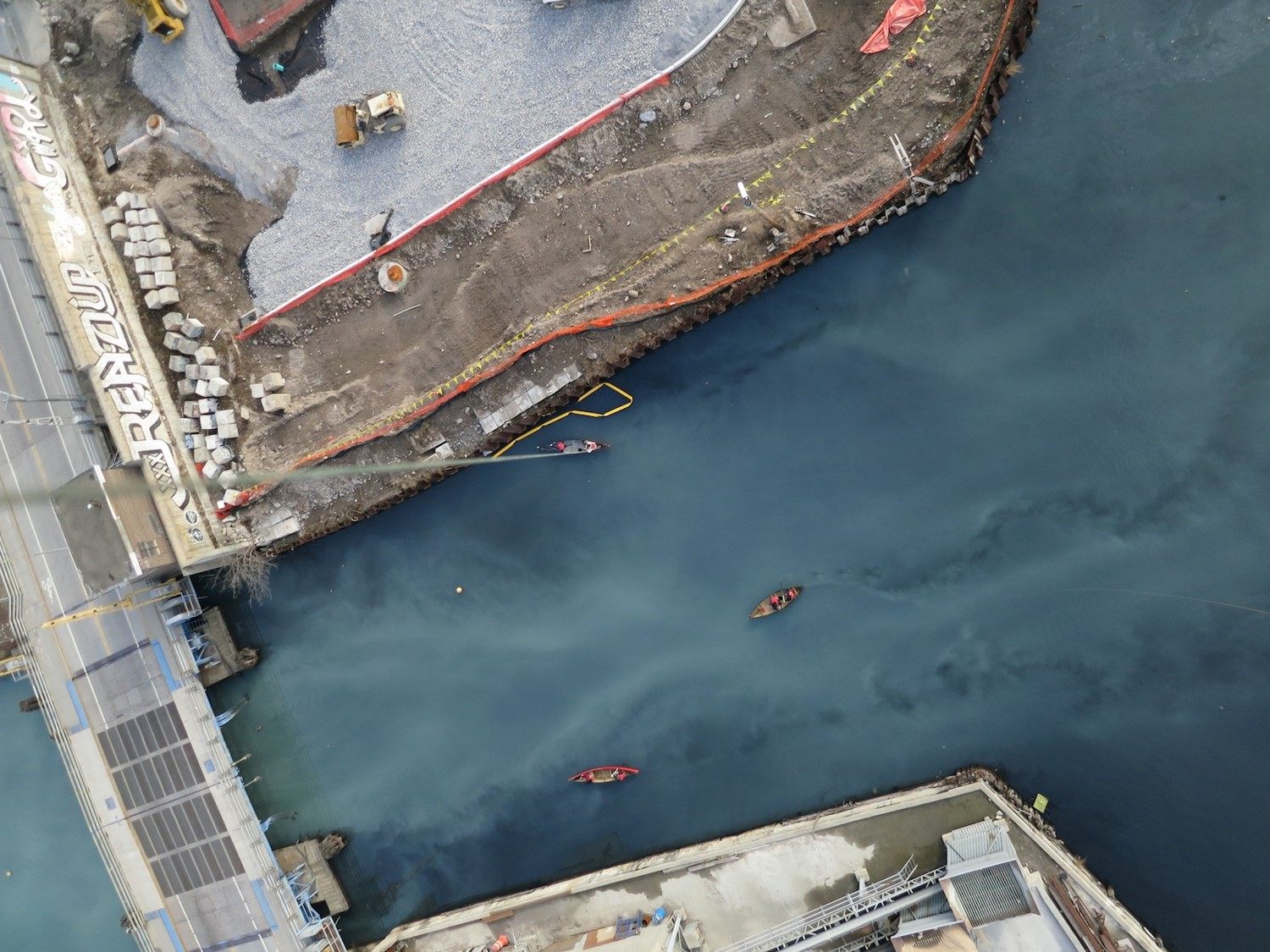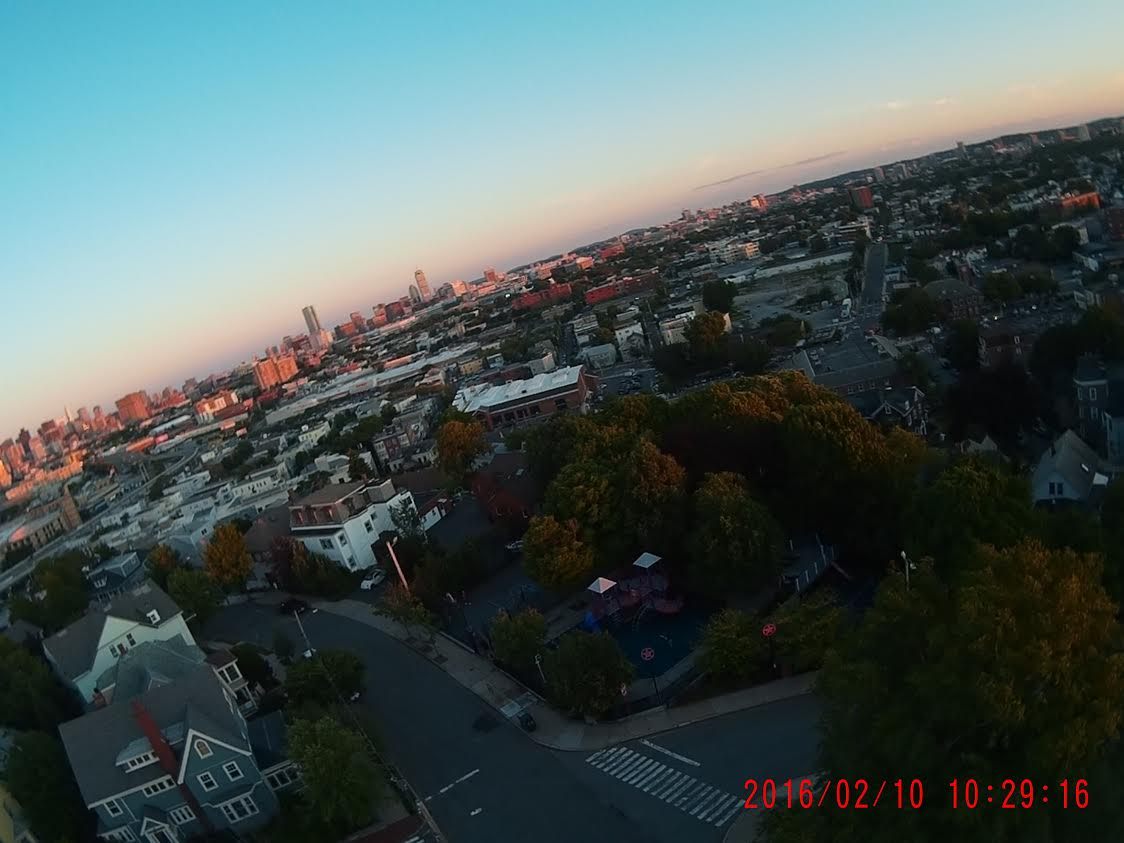Bringing Aerial Photography to the Masses—One Squid Kite at a Time
Public Lab’s DIY tools help communities keep tabs on the environment.

It’s a perfect July evening in Somerville, Massachusetts, a small crowd has gathered, and Jeffrey Warren’s squid just won’t get airborne. He tosses it into the air over and over again, waiting for a gust of wind. He tries launching it off the ramparts of the stone tower that sits at the crown of Prospect Hill. He runs it across the grass of the park that stretches out beneath. But each time the wind puffs half-heartedly and dies, and the squid—bright pink, with eight fluttering tentacles and two cartoony eyes—crumples to the ground.
You never need a reason to fly a kite. Nevertheless, Warren and his companions have one: They’re testing an improved version of an old invention, an aerial rig that will let them fly a camera up with the kite and take pictures from the sky (with a method cheaper, more widely available, and less intrusive than drones).
The squid kite is part of a new kit made by Public Lab, a nonprofit that helps individuals and communities use low-cost technology to learn about their local environments. (Warren is Public Lab’s cofounder and research coordinator.) What the Prospect Hill group learns tonight will help them make aerial photography easier for others—provided they can get anything in the air at all.

Public Lab is designed a bit like that squid kite—one big head, many arms. Originally started by a group of New Orleans–area DIY enthusiasts in the wake of 2010’s BP oil spill, the community has grown to include people all over the world. Members in many cities hold meetups, and also experiment on their own. They tweak and build off of each other’s work, and share results and new discoveries on a huge, shifting wiki. When there’s enough consensus about a particular tool, Public Lab puts together a kit—bundled materials and instructions that enable ordinary people to build and use the idea themselves.
The Lab has launched a lot of projects—there are kits for 360-degree camera rigging, water-quality monitoring, and desktop spectrometry, not to mention the many experiments that can be acomplished with ordinary household materials (such as this rig for a balloon camera, which uses a coat hanger and an iced tea bottle) or that require slightly more obscure tools (such as this dust mapper, which requires an optical particle counter).
But flying things have always hovered over the proceedings. “Kite mapping and balloon mapping have been a cornerstone of the work that Public Lab does,” says Bronwen Densmore, the Lab’s community manager. “They are two of the things that get the most use.”

Balloon and kite mapping existed before Public Lab, but over the seven years since the group’s founding, its many contributors have honed a methodology, complete with personalization and contingency plans. “All of these ideas and modifications get workshopped collaboratively online and in person, and we end up with a great set of resources,” says Densmore. The group on Prospect Hill has taken the advice of one online contributor—to balance the kite with a carabiner when it starts to list to one side. After the tenth or so attempt, it’s finally up, candy pink against the blue sky.
As another volunteer handles the reins, Warren unpacks the rest of his gear: a tiny camera and a small plastic case. He fits the camera snugly into the case, turns on the automatic photo setting, and attaches it to the string of the kite. As the squid rises, its string unspooling like its real-life counterpart might tug a fishing line, the camera comes along, higher and higher.
Provided it descends safely, the camera will bring a lot of pictures back down, some of which are bound to be useful—or, at the very least, interesting. Since the advent of hot air balloons in the 18th century, aeronauts have known that views from above can change the way people think about the landscape and encourage a broad perspective that allows us to see how different aspects of a space fit together.

Add an environmental perspective, and the possibilities snap into focus. Public Labbers have used kites and balloons to track invading water chestnuts, coastal restoration efforts, and the progress of an oil pipeline in Western Canada. They use the insights they’ve gained to advocate for change, whether by tracking and reporting water pollution or documenting the sizes of protests. In the best cases, real changes occur. In southern Lebanon, a whole team has mobilized flying cameras to map the refugee camp where they live, to track overcrowding and find good locations for green space.
Often, the resulting photos inspire as many questions as they answer. When Edmund Diegel’s work mapping plant cover around the Gowanus Canal revealed unexpected ice-melt patterns, he began seeking out Brooklyn’s many “ghost streams,” or brooks covered up during the city’s construction. And as those 18th-century hot air balloon mappers knew, just viewing the place you live from a different angle can spark insights. When the camera came down and picked up a series of views of Somerville—with houses and businesses packed to the horizon—the city’s status as the most densely populated space in New England was suddenly made real and visceral.
Over the years, technological progress and teamwork have combined to make perspectives like these even more accessible. “People have worked out a lot of great solutions for rigging and stabilizing [the kites and balloons], and getting different kinds of things up in the air,” says Densmore. The proliferation of inexpensive, lightweight cameras has been a huge boon. “People can get started without having to look for helium tanks,” says Densmore.

Still, the new mini-balloons and kites are “prototyping kits”—Public Lab–speak for “not quite there yet.” Prospect Hill is acting as a proving ground, where wrinkles can be found and ironed out. And mistakes are made. On its first flight up the squid kite string, the tiny camera is upside down. On its second, it slips free and bounces off a few tree branches before it lands hard on the pavement. (And is out of commission for the evening.) “Ok, so when the line goes slack, the rigging falls out,” Jeff says, clearly stowing that tidbit in his head for later. “We just did some science!” He then jogs over to a passerby: “Hey, did you see that camera fall out of the sky?”
Throughout the exercise, neighbors stop to ask questions, take a turn on the strings, or just gawk skyward for a moment. In a moment when aerial photography is often associated with furtiveness—silent drones, hidden cameras, surveillance towers—Public Lab has cultivated an contrasting ethos, from their open-source hardware to their bright pink designs.
“One thing about the kites and balloons that’s really nice is that they force you to be in the space that you’re mapping,” says Densmore. “And they tend to spark a lot of comunity engagement, whether that’s your intention or not.” After all, if you see a squid in the sky, you’re probably going to stop and say hello—and maybe, eventually, join the shoal.













Follow us on Twitter to get the latest on the world's hidden wonders.
Like us on Facebook to get the latest on the world's hidden wonders.
Follow us on Twitter Like us on Facebook